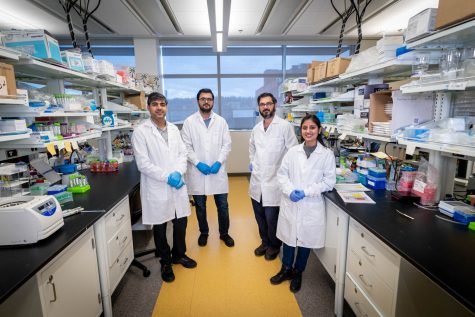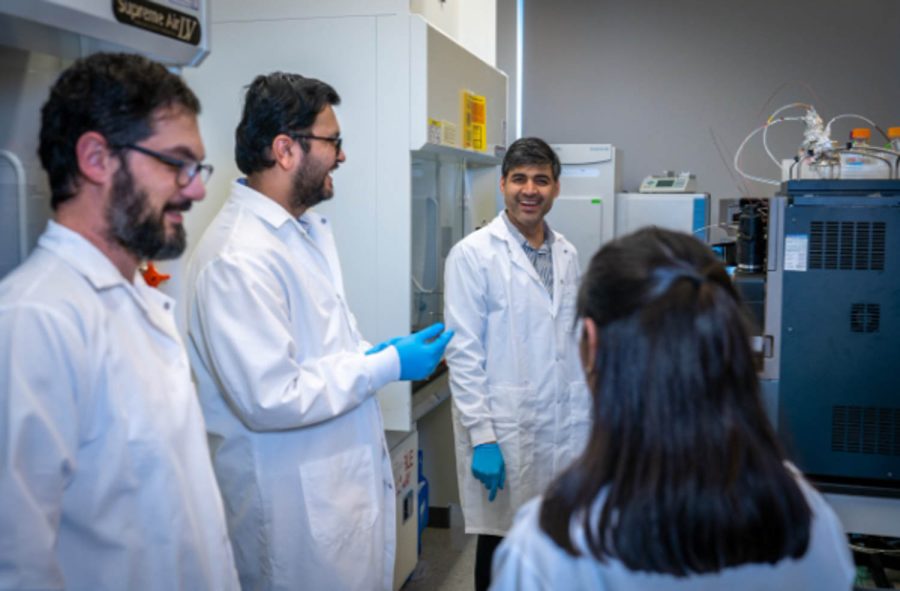WSU researchers study drug dosing safety in underrepresented populations
Scientists are currently researching how to make drug dosing standards safer for children, pregnant women and Native Americans
Dr. Prasad and some team members in the lab.
February 22, 2023
WSU scientists are currently working on research to develop safer drug dosing standards for underrepresented populations such as children, pregnant women and Native Americans in clinical trials.
Bhagwat Prasad, associate professor in the College of Pharmacy and Pharmaceutical Sciences, is the leader of this research. He said the scientists involved with the project are interested in looking at the body’s ability to handle drugs.
“We all are different with how we handle drugs,” Prasad said. “We look at physiological differences in drug handling processes inside our body related to sex, age.”
Prasad said he has been working on this research at WSU for the past eight years. Some of the underrepresented populations in drug testing include children and the elderly.
“Drugs are not tested on pregnant women for example,” Prasad said. “Drugs have not been tested in more minority populations. There are very few drugs for which safety data are available in underrepresented populations such as Native Americans.”
At the moment, the lab working on this research consists of about 11 people, he said. Of the 11, there are six graduate students, one pharmacy student and the other four post-doctorate students.
Pharmacy doctorate student Siavosh Naji-Talakar is one of the members of the research team. He said they focus on developing mathematical computer models that can help predict how drugs will act for different people.
“Even you and your family members can have completely different bodies and the way you might respond to drugs could be completely different,” Naji-Talakar said. “We analyze tissue samples from thousands of biobanks, from children to adults and then we take that data to generate computer models based off these advanced models which we employ to predict how drugs can affect you.”
Naji-Talakar said the mathematical models can take the drug and run simulations to determine if it will be dangerous to a certain population and from that research, can eliminate populations that may be at a high risk from taking the drug.
“If they’re only studied on white male populations, that doesn’t give us a good idea of who’s going to take it,” he said. “Many of these minority populations, these are the people who we’d like to have more clinical trial tests so we can get a bigger idea of the entire human population.”

From his research, Prasad said one of the most notable findings is that the highly valuable protein UGT2B17 is not found in about 20% of Caucasians This protein is important in metabolizing a lot of drugs, so it can affect how a person reacts to a drug.
“We’ve found in our lab that women have lower levels of this protein than men. We have also seen that kids below nine years of age don’t express this protein,” Prasad said. “The drugs that are metabolized by this particular protein, you’re going to see high concentrations in their blood. We have tested a number of drugs that we are all taking every now and then. Those drugs are being metabolized by UGT2B17. We think this could be a public health concern.”
From this research, Prasad said he hopes it can help the pharmaceutical industry select the right dose when testing drugs depending on the population.
Naji-Talakar said drug companies could alter their clinical trials from the research they have been working on. In addition, this research can lower drug prices and help lead to better and more effective drugs.
“We’re really hoping to change the way the FDA guidance has on drug development and make sure they’re good for all humans. There’s a lack of understanding on how peoples’ response to drugs may vary,” Naji-Talakar said. “We want to show you have to do additional testing to make sure your drug is safer.”











